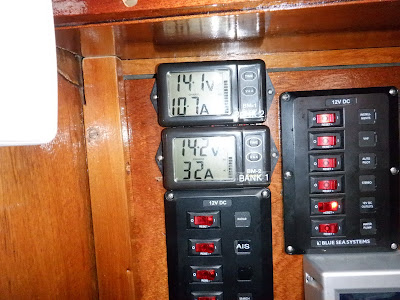Battery Monitoring.
It is difficult to effectively manage your batteries with no information, at a minimum you need a volt meter and preferably an ammeter. A Battery monitor is good for an overview of the systems but in practice only gives an approximation of the depth of discharge, but it will usually include good voltmeter and ammeter functions.
Voltmeter
When not charging the voltmeter will give an indication of the state of charge by reference to one of the many charts available on line. 14 Volts or thereabouts will show the battery is being charged. You need one per battery bank or one that is switchable. Some marine instruments, plotters etc will show the voltage from the battery they are running from often with an alarm function for low voltage which is useful. Also some solar and wind controllers will show the battery voltage.
Ammeter
Tell you what is going into or out of the battery, some older meters are inserted in the main power feed(s), this is generally not a good idea as it extends cable runs and may exclude some high current devises. Better is the type with a shunt in the negative line close to the battery and a remote display which measures the voltage drop across the shunt which is of know and low resistance and uses Ohm's law (Amps = Volts / Resistance in Ohms) to convert to current.
Having one for the starter battery can be useful but is perhaps a bit of a luxury, a volt meter should be enough and I use the one built into the wind and solar controller which has an outlet dedicated to the starter battery, that shows the voltage and the current charging profile - Bulk when recharging a partially discharged battery, Float when just keeping a charged one one topped up.
 |
| The shunts for the two domestic systems are to the right above the battery. |
Battery Monitors
 |
| NASA marine mini battery monitors for the two domestic banks top left. I rely on the volt metre built into the solar and Wind controller for the state of the starter battery. |
Battery monitors follow a number of strategies for reporting the depth of discharge and the likely time to fully charged or discharged at the current charge or discharge rate.
They typically use a stead state voltage to recognise how much the battery is charged then it integrates the current through the ammeter shunt to keep track until it can get another fix.
This works reasonably well in a simple system but it gets badly confused with mine due to the solar and wind charger charging the batteries, perhaps continuously, so that the unit has to rely on this integration for extended periods. Frequently it will be saying that the batteries are 85% charged then after a few minutes of charging at a few amps it will say its 104%. Sometimes it will show 104% then after a few minutes of light discharge will show 90% or there abouts. It can be unconfused by turning off the solar / wind controller and shore power for a while and with the engine not running, putting the batteries under light load until things stabilise and gives a sensible reading, that can be checked by using the volt meter function and a volts vs charge graph or table. However it does give a reasonable indication once below c 90% and is a useful guide.This will reduce as the batteries become charged or heat up and the intelligent controller tones things down to protect the batteries and alternator.
Battery Charging Strategies.
Batteries accept charge more slowly when they are are close to fully charged so if the engine has to be run just to charge the batteries wait until the batteries are down c 70% or lower and recharge to 80-90%. The last 10% and in particular the last 5% will take a long time so it is much better to charge from 70% - 80% three times than from 70 - 100% once (or 80 - 90% twice than 80 - 100%). The exception to this "rule" might be on the approach of a storm in which case you may want everything fully charged just in case. If you don't have a battery monitoring system then check the rate of charge and stop charging when the current starts to drop significantly.
Increasing engine speed above a fast idle is unlikely to significantly increase charging rate and will use more fuel but check the engine manual, diesel engines prefer to be worked reasonably hard and deposits can start to form with prolonged slow running, the Yanmar manual states:
The two hours is going to be cumulative so running at idle for 2 one hour charges, which is probably all that would be required in many cases, would count and personally I would race the engine towards the end of any charging period.
A better option, unless you are racing or completing a Jester Challenge or similar when engine propulsion is not allowed, is probably to put the engine in gear when charging and improve your speed.
If like me you end up with two banks of batteries, do not run them in parallel (which in any case breaks the "rules" of connecting batteries in parallel) and unless you have serious charging capacity don't switch frequently, let one go well down but clear of the safe discharge limit, say to 65-70% charged on a VRLA / Flooded battery or 50%-60% on an AGM then either swap banks or charge the depleted to 85 or 90% as described above. When charging a single discharged bank from two, set the isolation switch on a DVSR to "off" to prevent the charged battery discharging to the other, a diode based system will do this automatically, see the page on "switching".
Continue to What would I do differently if starting now?

No comments:
Post a Comment